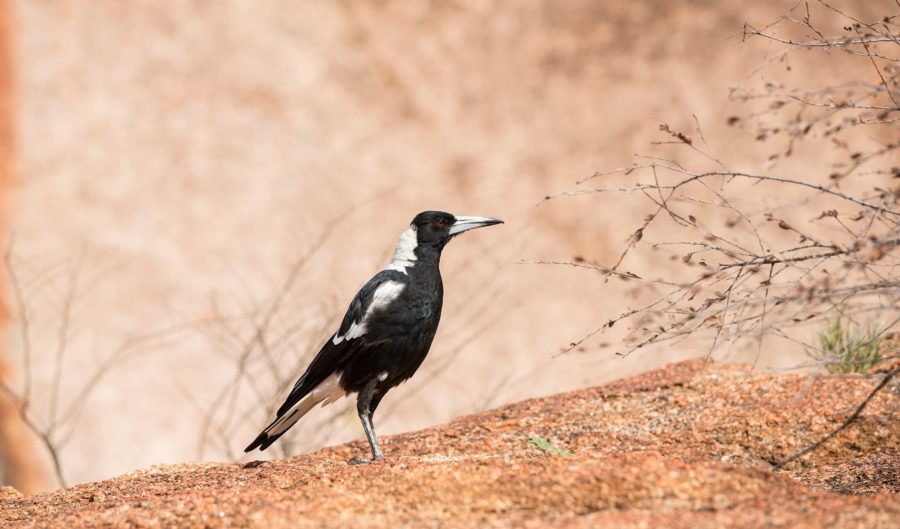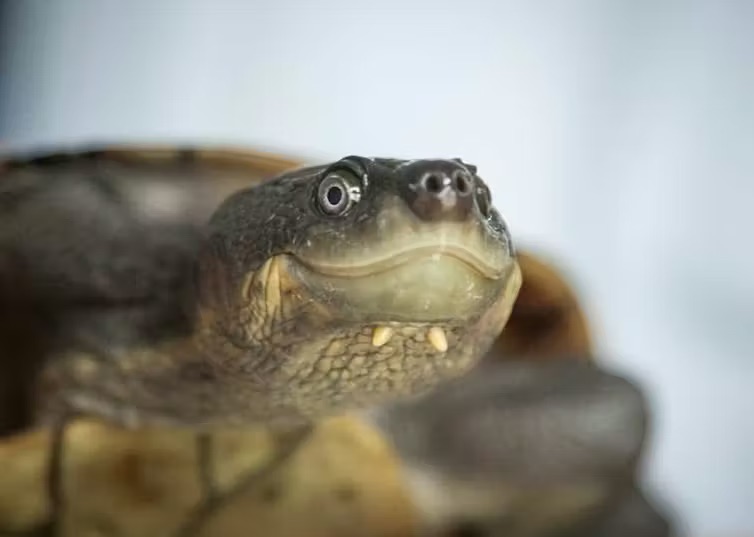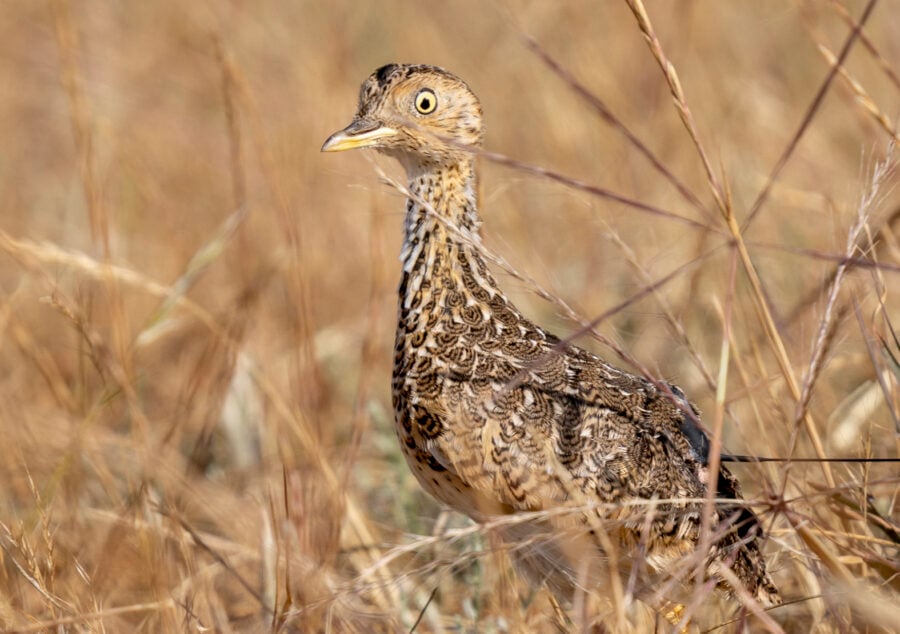Feathered geniuses: Birds are much smarter than we think

“I’ve seen such separations in magpies several times and it’s every bit as mean and heartbreaking as it is for human beings,” explains Professor Gisela Kaplan, a neuroscience and animal behaviour expert at the University of New England, who is interested in the social life of birds and has studied wild magpies for more than 20 years.
Extensive field research has allowed her to witness goings-on in magpie society that other observers may miss.
“The nastiest case concerned a pair I’d watched for years. One day the male disappeared for days, leaving all the feeding of two offspring to the female. Then he came back with two young females and evicted his partner and her youngsters from the territory.”
Another time, a female evicted her male partner, apparently for not protecting their nest and youngsters well.
“She didn’t allow him near the nest. Eventually another male turned up and stayed,” says Gisela, who’s found that when a male takes over another’s territory, he plays no part in raising his predecessor’s young.
“I ended up support-feeding the two offspring as the female was clearly struggling to raise them on her own.”
Gisela has studied about 30 magpie groups on the Northern Tablelands of New South Wales and the adjacent coast, as well as in Victoria and outback South Australia.
Given that her chosen fields are cognition, communication, song-learning and mimicry, particularly among Australian birds, stable social groups make ideal research subjects.
During the past two decades she has published 250 research articles and 21 books, spoken on radio and been a consultant for television documentaries.
In her award-winning 2015 book, Bird Minds: Cognition and Behaviour of Australian Native Birds, Gisela draws on her own extensive research, as well as the work of other scientists, to show how smart, sensitive and perceptive Australian birds really are.
Growing evidence suggests many bird groups, including all modern songbirds, evolved in East Gondwana (now Australia) and spread around the globe millions of years ago, taking their skills with them and spawning more than half the bird species on Earth today.
Australia, it turns out, was a cradle of bird evolution after the mass extinction that claimed the dinosaurs about 66 million years ago.
What gave Australian birds their unique talents?
Gisela believes one factor was this continent’s harsh and ever-changing environment.
To survive here, birds had to be highly adaptable, innovative and good decision-makers.
Another factor was cooperative behaviour. Birds that lived in close-knit social groups and helped each other – raising young, defending nests and/or finding food – were more likely to prosper. A stable family life lies at the core of such cooperation.
“There is no other class of animals that has such a high incidence of pair-bonding and joint parenting as do birds,” Gisela writes, “and, in Australia, this is often coupled with life-long commitments.”
That’s until divorce do them part, of course.
Gisela’s book is a treasury of examples of the astonishingly sophisticated behaviour of Australian native birds.
She tells of problem-solving, tool use, empathy, grieving, forward planning, cooperative defence, facial recognition, mimicry, imitation, song-learning, long memory, deception, Machiavellian scheming, brain plasticity, complex play, counting and even pointing behaviour (the first time this had been reported in a bird).
Bird brain
UNTIL THE 1900s, many people ridiculed the idea that a creature with a brain as small as a bird’s might be capable of complex learning, let alone thought or emotions.
Although Darwin suggested human mental powers differed from those of other animals only in degree, not kind, the consensus was that birds ran on instinct and were mentally on a par with insects and fish.
Size was deemed to matter: big brains were smarter than small ones. Birds were, well…bird-brained.
As proof, sceptics pointed out that birds lacked a forebrain, the powerhouse of higher mammal thinking, although this notion failed to appreciate evolution’s breathtaking ingenuity.
To lighten the avian brain for flight, natural selection has miniaturised it ruthlessly.
In a cockatoo, for example, it can be walnut-sized.
But, as well as having often elaborate social relationships, birds move through a complex three-dimensional world at great speed, dodging obstacles, judging distances, gauging wind speed and direction, and calculating approaches to tight landing spots or prey.
The torrent of information entering the brain must be processed in microseconds. How does this tiny organ do it? The answer has become clearer in recent years.
We now know birds do have the equivalent of a forebrain. It’s called the pallium and although it differs structurally from the mammalian forebrain, it sits in a similar position and performs a surprising number of similar functions.
Just as significantly, in 2016, an international group of neuroscientists published the results of a study that showed that birds pack twice as many neurons per unit of mass into their brains as monkeys and apes do.
“Thus, large-brained parrots and corvids [crows and ravens] have forebrain neuron counts equal to or greater than primates with much larger brains,” the scientists concluded.
“Moreover, a short interneuronal distance, the corollary of the extremely high packing densities of their telencephalic neurons, likely results in a high speed of information processing, which may further enhance cognitive abilities of these birds.”
So, it turns out, the avian brain is a super-clever smartphone beside the desktop computer that fills the mammalian skull.
In response, the media lit up with headlines about “feathered apes” and birds not being bird-brained after all.
In his 2016 book, Bird Brain: An Exploration of Avian Intelligence, Nathan Emery, a cognitive psychologist at Queen Mary University in London, describes birds as “Einsteins of the air”.
Some birds should be considered as intelligent as apes and dolphins, and may match our earliest human ancestors in cognitive prowess.
He adds that “rooks, jays and New Caledonian crows are at least as competent and, in some cases, more competent than children younger than eight years old in tasks involving tool innovation and causal reasoning”.
However, it’s clear that, where brainpower is concerned, not all birds are equal, and avian cognitive skills vary enormously.
Our smartest birds are cockatoos and parrots, with palm cockatoos and budgies in the lead.
Close behind are ravens, crows, bowerbirds and magpies.
Even some smaller birds, such as wrens and honeyeaters, score surprisingly well on the intelligence scale.
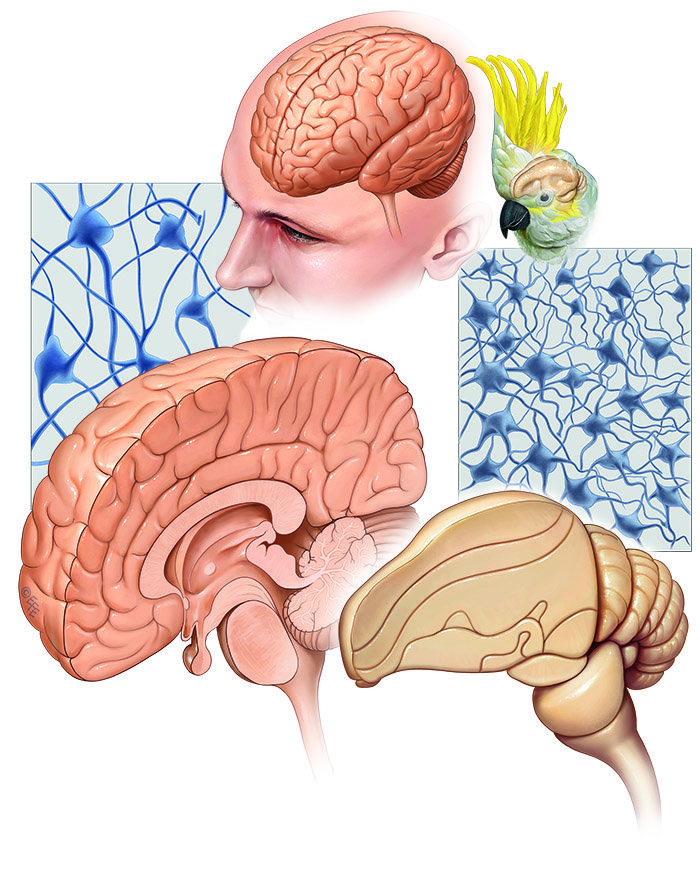
Until recently, it was thought that because birds lacked a neocortex they weren’t capable of complex thought and ran purely on instinct. But science has found that the avian forebrain, consisting of the pallium and its various components (such as the nidopallium), has functions similar to those of the mammalian neocortex. (Image Credit: Levent Efe)
Tool use
BEFORE THE 1960s, tool use was thought to be the exclusive preserve of humans; a mark of superior intellect that separated humanity from other life forms.
But that notion came crashing down when primatologist Jane Goodall discovered in 1960 that wild chimpanzees modify twigs to catch termites.
Since then, birds have joined the top ranks of tool-making and tool-using animals.
Several species fashion sticks for reaching and hooking food and also for use as weapons or playthings.
The New Caledonian crow is a champion maker and user of tools, meticulously fashioning a range of barbed sticks with which it extracts grubs from tree bark.
Biologist, author and AG contributor Tim Low describes in his latest book, Where Song Began, how he watched a young crow in a New Caledonian rainforest using a tool to fish out a cricket from a tree hole.
“I was astonished,” Tim told me. “The young bird was so smooth, so deft in its operation. There was nothing tentative or clumsy about it; it knew exactly what it was doing.
“When you’ve been watching birds all your life, to see a bird operating at a level of sophistication that is just way above anything you’ve seen before, you have a sense of awe,” he concluded.
Published the year before Gisela’s book came out, Where Song Began explores comprehensively the view that more than half of the world’s birds originated in the Australian region and explains why so many of our birds are unusually intelligent, social and noisy.
Avian tool users in Australia include the male palm cockatoo, which fashions sticks with which to drum on tree trunks.
Scientists aren’t sure why, but believe it’s either to warn off intruders or signal his readiness to mate.
He may carry a good drumstick around to different trees and also removes leaves and twigs from sticks that he then cuts to a precise size for building a nest in a tree hollow.
His tool-making skills are equal to – some say more sophisticated than – those of the New Caledonian crow.
Like corvids and raptors elsewhere in the world, Australian birds may use stones for a variety of purposes.
The black-breasted buzzard wields a stone with its beak to crack open eggs and a group of magpies reportedly dropped stones on the tin roof of a farmhouse in the morning if the residents were late in putting out food for them.
Aboriginal people in the Northern Territory tell of raptors spreading bushfires to flush out prey.
Bob Gosford, an NT lawyer who has worked with Aboriginal people in central and northern Australia, has heard talk of raptors picking up smouldering or burning sticks and flying as far as 50m to drop them on unburnt patches of dry grass to start new fires.
“There is compelling evidence that at least two raptor species – the brown falcon and the black kite – act as propagators of fire within the Australian savanna woodlands,” Bob wrote in the digital magazine Crikey.
For millennia, the wildfires that shaped the Australian landscape were started either by lightning or by humans.
Bob believes that raptors may be a third fire-promoting force and he’s researching Aboriginal accounts of this behaviour.
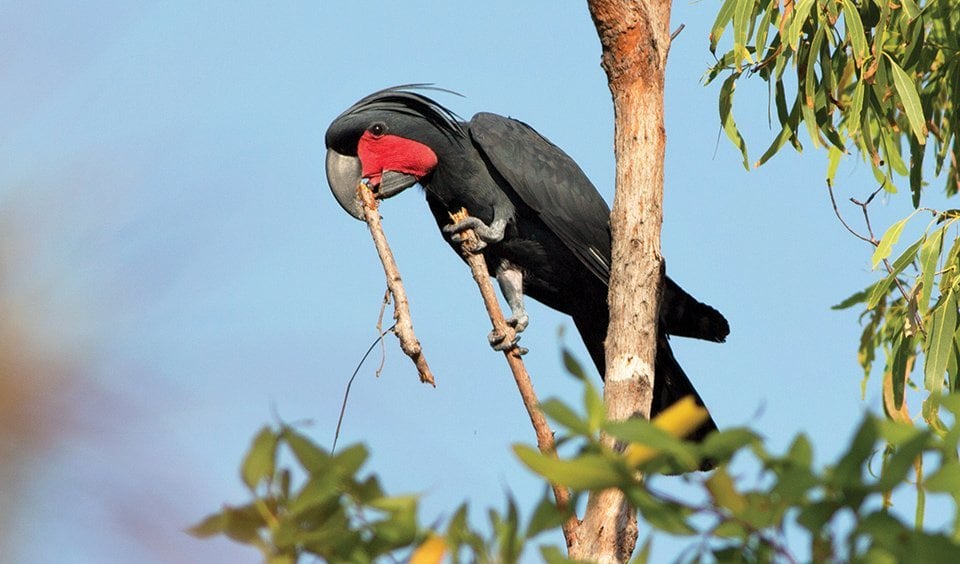
A male palm cockatoo prepares to drum on a branch. If he likes the stick, he’ll carry it with him to his next drum site. (Image Credit: Christina N. Zdenek)
Communication between birds and humans
AG PHOTOGRAPHER Don Fuchs once had an encounter with a raven in an aviary in Austria that gave him food for thought.
“The bird looked at me and I looked at it and then it picked up a twig and pushed it through the mesh towards me,” Don says.
“So I took it and immediately the bird lifted a wing to expose its underside. It seemed to be indicating that it wanted me to scratch it. So I did and the bird half-closed its eyes and its head went back a little and it was quite clear to me that it was enjoying what I was doing.”
After a while, Don stopped scratching and pushed the stick back inside.
“The bird was not happy. It grabbed the stick and pushed it out again, basically ordering me to keep going,” he recalls.
“What was amazing was that I really felt that there was clear communication between us.”
The raven had communicated with Don through gesture, expression and the manipulation of a tool. But as Gisela says in her book, one of the hallmarks of bird communication is vocalisation.
“Apart from humans, no other class of animals has developed such a plethora of vocal signals as have birds,” she writes.
Complex calls seem to go with cooperative living and intelligence.
Scientists are now finding that many bird calls have a fixed meaning; in other words, they show the beginnings of a vocabulary.
Professor Darryl Jones, a behavioural ecologist at Queensland’s Griffith University, has studied urban crows and magpies.
A research project he ran on the vocal communication of Torresian crows revealed that they employed as many as 200 different elements.
“They genuinely appear to have what you’d have to call language,” he says.
“They don’t make noise for no reason and they talk to each other all day, every day, and so something is going on. There are enough bits to it and they talk to each other enough for us to speculate that they may even have sentences.
“That’s the kind of thing that always makes me think that these are smart birds,” he continues.
“They’re communicating in a really sophisticated way.”
Deep in the wilds of Tasmania, ravens and currawongs exploit a different form of intelligence to great advantage.
At two sites on the Overland Track, bushwalkers regularly discard their backpacks to make short side trips. Once the walkers have set off, the birds descend on the packs.
They’ve learnt not only which outer pockets walkers usually store their day snacks in, but also how to unzip them.
“They’ve got keen eyes and can easily spot that little metal zipper tag,” says Rob Armstrong, a discovery ranger with Tasmania’s Parks and Wildlife Service.
“They’ll pull out everything until they find food. They’re mainly after ziplock bags, where people keep their scroggin mix – fruit and nuts and things like that.
“Once they find what they want, they don’t put the other stuff back in, of course, so a lot of rubbish gets spread around those sites.”
In a bid to reduce the mess, the service has put up signs that warn: “PROTECT YOUR PACK! Currawongs can undo zips – and they know where you keep your snacks!”
Bird play
DO BIRDS like to have fun? Do they play? Some bird species do, but they represent only a tiny fraction of the world’s 10,000 species of bird.
Parrots, corvids and Australian magpies top the list of imaginative players, although scientists keep finding other species to include.
Theoretically, in evolutionary terms, play should offer a survival advantage. So birds that live in tight social groups may play with one another because it promotes social skills and bonds the group.
Chasing, tussling, hiding or tug-of-war games may hone brain synapses, muscles and motor skills, and playing with objects may nurture inventiveness or build handy expertise that will one day provide food.
But then perhaps play could just be for fun.
I’ve watched a flying wedge-tailed eagle playing with a dead rabbit, dropping it and then diving and catching it, over and over.
I’ve seen ravens launch themselves repeatedly from a cliff to perform wild aerobatics, wheeling, tumbling, diving, rolling and looping in the updraft.
I once saw a pelican take off on a hot day and spiral up in a thermal to the cloud base before returning to its original resting place. I assumed it had gone up to cool off but then maybe it was for the sheer pleasure of free flight.
Gisela has watched young magpies play hide-and-seek, during which one magpie finds a desirable object such as a leaf and runs off with it and hides while others chase and search.
“It’s a game of disappearance and reappearance,” she says.
“They often vocalise while they’re doing this, and when they find the other, they squeak and squeal and have wonderful fun.
“Significantly, they understand that an object that was initially in their field of vision and then disappeared is actually still there.
“Human children don’t develop such concepts until they’re three to five years old.”

Birds of prey, such as this wedge-tailed eagle, seem to enjoy playing with objects, including animals they have hunted and killed. (Image Credit: James Niland)
A deeper appreciation
BIRDS ARE all around us. We see and hear them every day. That may be why we take them for granted and dismiss them as just another element of our environment.
Although we’re coming to understand how intelligent some of them are, we’re a long way from having the full picture.
It’s clear, however, that humans have long underestimated birds’ capacities and complexity, and grossly overestimated their own.
A lot more work needs to be done. We could start by using the term bird brain as a compliment rather than an insult.
READ MORE:
